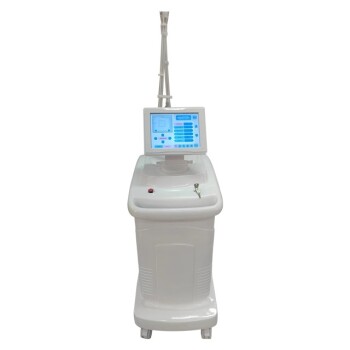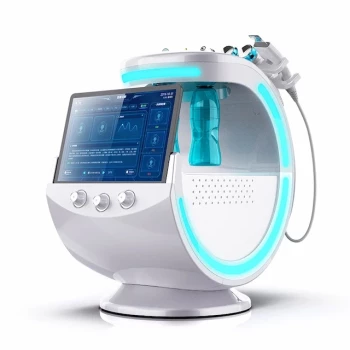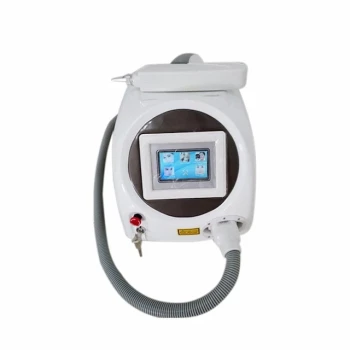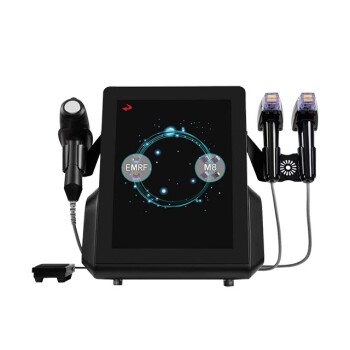Determining suitability for a CO2 laser treatment is a critical safety step that depends on several factors beyond the simple desire for skin rejuvenation. While a powerful tool, this ablative laser is not a one-size-fits-all solution. The most significant contraindications involve individuals with very dark skin tones, those with active skin infections or inflammatory conditions, and patients taking certain medications or with a history of poor scarring.
The decision to undergo a CO2 laser procedure hinges on a simple risk-reward calculation. The procedure is safest and most effective for individuals with lighter skin tones seeking to correct significant sun damage or wrinkles. For others, the risk of pigmentation changes, poor healing, or infection outweighs the potential benefits.
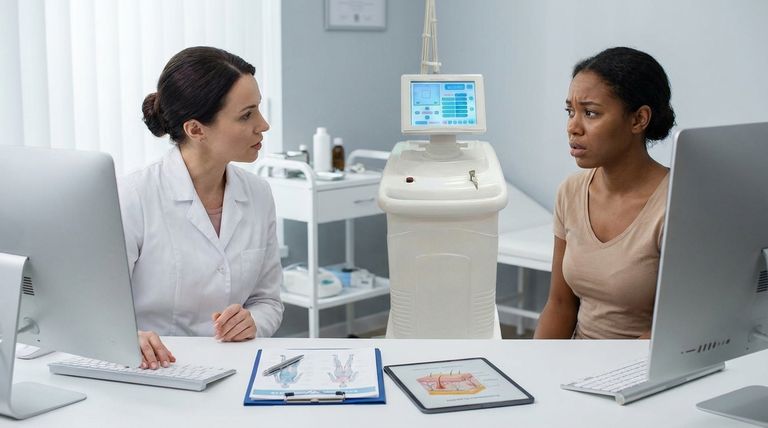
Skin Tone and Pigmentation Risks
The primary concern with any light-based therapy is how energy interacts with melanin, the pigment that gives skin its color. CO2 lasers are aggressive, and this interaction is a critical safety parameter.
The Fitzpatrick Scale as a Guide
Dermatologists use the Fitzpatrick scale to classify skin types based on their reaction to UV light. It ranges from Type I (very fair, always burns) to Type VI (deeply pigmented, never burns). This scale is essential for predicting how skin will react to a laser.
High Risk for Darker Skin (Fitzpatrick IV-VI)
Individuals with darker skin tones, typically Fitzpatrick types IV, V, and VI, are generally not good candidates for traditional, fully ablative CO2 lasers. Their skin contains a high amount of melanin, which can absorb the laser energy in an unintended and unpredictable way.
This can lead to serious complications, including:
- Post-Inflammatory Hyperpigmentation (PIH): The development of dark patches in the treated areas.
- Hypopigmentation: The permanent loss of normal skin color, resulting in light or white spots.
Tanned Skin Is a Temporary Contraindication
Even if you have a suitable Fitzpatrick skin type (I-III), you are not a good candidate if you have a recent tan or significant sun exposure. Tanned skin has an increased amount of melanin, temporarily placing you in a higher-risk category similar to someone with a naturally darker skin tone. Most practitioners will require you to avoid sun exposure for 4-6 weeks before treatment.
Active Skin Conditions and Infections
The CO2 laser creates a controlled wound to stimulate healing. Introducing this trauma to skin that is already compromised is a recipe for complications.
Active Acne
Treating skin with active, inflammatory, or cystic acne is a major contraindication. The laser's heat can vaporize pustules, potentially spreading bacteria across the face and triggering a much more severe breakout. The underlying inflammation also interferes with a clean healing process.
Active Infections
Any active infection in the treatment area is an absolute contraindication. This most commonly includes the herpes simplex virus (cold sores). The trauma from the laser can trigger a severe, widespread outbreak. Patients with a history of cold sores are typically prescribed a course of antiviral medication to take before and after the procedure as a preventative measure.
Inflammatory Skin Disorders
Those with chronic inflammatory conditions like eczema, psoriasis, or severe rosacea in the treatment area are poor candidates. The aggressive nature of the CO2 laser can severely exacerbate these conditions and lead to a prolonged and complicated recovery.
Understanding the Trade-offs and Limitations
Beyond absolute contraindications, some individuals are poor candidates because their expectations do not align with the laser's capabilities or they cannot accommodate the recovery process.
Deep Wrinkles vs. Unrealistic Expectations
While CO2 lasers are a gold standard for treating moderate to severe static wrinkles, they have limitations. An individual with extremely deep, etched-in lines or significant dynamic wrinkles (those caused by muscle movement) may be disappointed if they expect complete erasure. These often require a multi-modal approach, combining laser resurfacing with neurotoxins (like Botox) or dermal fillers.
Sagging Skin vs. Surface Texture
The CO2 laser is a resurfacing tool, not a lifting tool. It excels at improving skin texture, fine lines, wrinkles, and pigmentation. While the collagen stimulation provides a modest tightening effect, it cannot correct significant skin laxity, such as jowls or a sagging neck. A person whose primary concern is sagging is a poor candidate for laser alone and should be evaluated for surgical options like a facelift.
The Demands of Recovery
The downtime after a CO2 laser is significant, often requiring 7 to 14 days of intensive post-procedure care. If your job, lifestyle, or social commitments do not allow for this period of visible healing (redness, peeling, swelling) and strict sun avoidance, you are not a good practical candidate for the procedure.
Making an Informed Decision
A thorough consultation with a board-certified dermatologist or plastic surgeon is non-negotiable. They can properly assess your skin and medical history to determine your suitability.
- If your primary focus is safety: Anyone with dark skin (Fitzpatrick IV-VI), an active infection, or a history of keloid scarring should avoid ablative CO2 lasers and explore alternatives like microneedling or gentler, non-ablative lasers.
- If your primary focus is correcting severe wrinkles or sagging: Discuss a combination approach, as a CO2 laser alone may not meet your goals for deep dynamic lines or significant laxity.
- If your primary focus is minimal downtime: You are a better candidate for a series of less aggressive treatments, such as chemical peels, microneedling, or non-ablative fractional lasers.
Ultimately, a good candidate is one who is well-informed, has realistic expectations, and whose skin profile minimizes the risk of adverse outcomes.
Summary Table:
| Contraindication Category | Key Reasons & Risks |
|---|---|
| Darker Skin Tones (Fitzpatrick IV-VI) | High risk of hyperpigmentation (dark spots) or hypopigmentation (light spots) due to melanin interaction. |
| Active Skin Conditions | Active acne, cold sores, eczema, or psoriasis can worsen or lead to infection and poor healing. |
| Certain Medications/History | History of keloid scarring or taking medications (e.g., Accutane) that impair healing. |
| Unrealistic Expectations/Needs | Significant sagging skin requires lifting surgery; deep dynamic wrinkles may need combined treatments. |
Ensure Optimal Patient Outcomes with Professional-Grade Equipment
Choosing the right technology is the first step to ensuring patient safety and achieving exceptional results. BELIS specializes in providing medical aesthetics clinics and premium beauty salons with advanced, reliable laser systems and comprehensive support.
Partner with BELIS to empower your practice:
- Advanced Technology: Offer a range of treatments with equipment designed for efficacy and safety.
- Expert Guidance: Receive professional training and support to maximize your treatment protocols.
- Build Trust: Enhance your clinic's reputation by investing in quality technology that prioritizes patient care.
Ready to enhance your service offerings and ensure the best outcomes for your clients? Contact our experts today to discuss the ideal equipment for your practice's needs.
Visual Guide
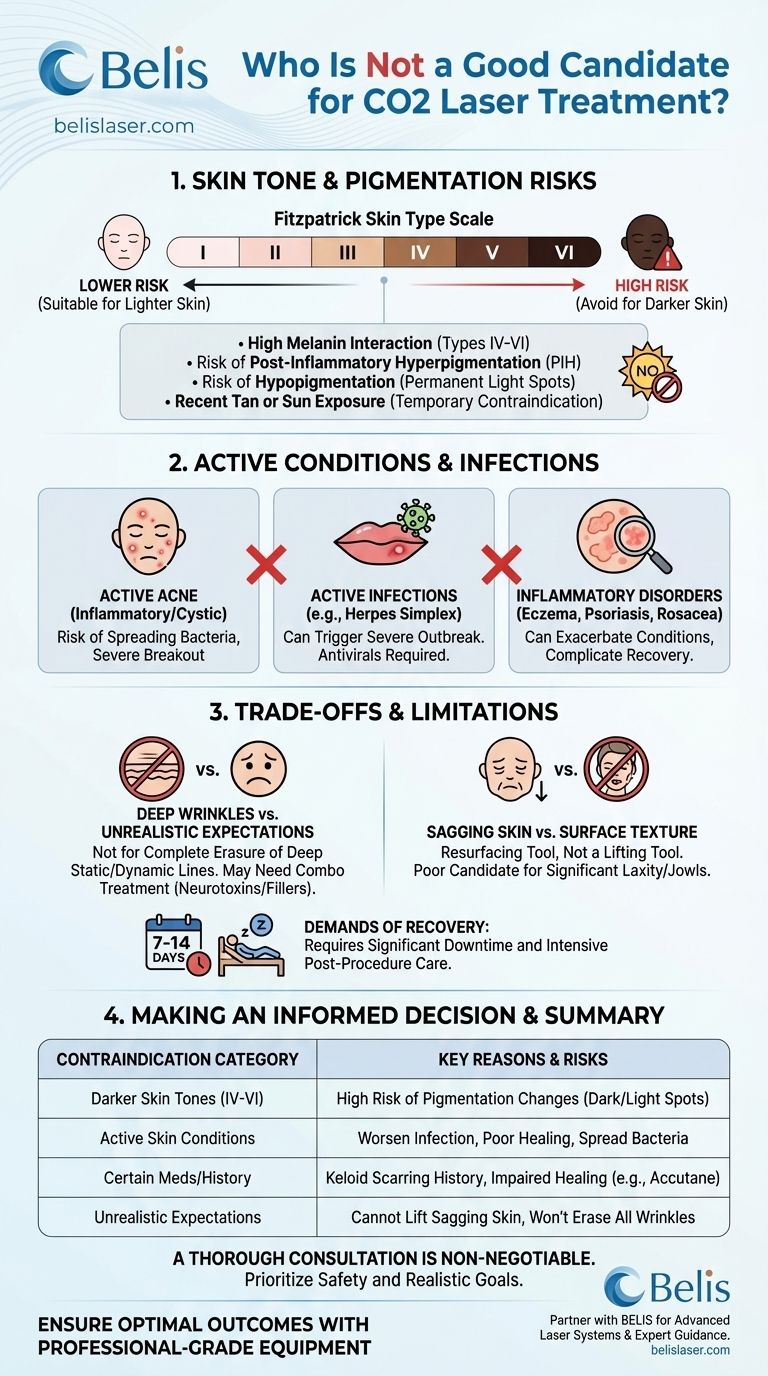
Related Products
- Fractional CO2 Laser Machine for Skin Treatment
- Fractional CO2 Laser Machine for Skin Treatment
- Hydrofacial Machine with Facial Skin Analyzer and Skin Tester
- Pico Picosecond Laser Machine for Tattoo Removal Picosure Pico Laser
- Hydrafacial Machine Facial Clean Face and Skin Care Machine
People Also Ask
- Is CO2 laser for all skin types? A Critical Guide to Skin Type Safety and Risks
- How does fractional CO2 laser work? The Science Behind Powerful Skin Renewal
- What is the downside of a CO2 laser? Weighing Dramatic Results Against Downtime & Risks
- Why am I not seeing results after a CO2 laser? Your Patience is the Key to Long-Term Skin Rejuvenation
- What does a CO2 laser do to your face? Achieve Profound Skin Resurfacing & Renewal
